An Ancient Language – Christian Art in Ethiopia
PRIMITIVE - Friday, December 11, 2015By Misaki Imagawa
Editor’s Note: When the imaginary Journals of Tobar were recently discovered it became apparent that we had a firsthand account of Christian life and art in Ethiopia. Special thanks to Misaki for unearthing this document. In it, Tobar tells us about his experiences and give us special insight into some of the treasures at PRIMITIVE.
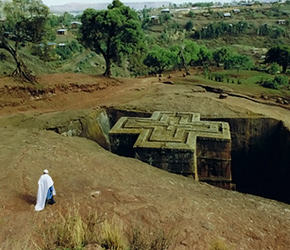 |
|
In winter, 1502, a low mist hung in the pre-dawn air in the rugged foothills of northern Ethiopia. A traveling merchant named Tobar emerged from his make-shift tent and stretched. The rest of the camp was still fast asleep. Tobar was only a temporary member of this band of traders. He had joined them just outside the port of Massawa in Eritrea, but the time had come for their paths to diverge. Spices and cloth were not his thing. He found the essentials of life almost boring. He was into art and culture, and all the byproducts produced by man’s quest for beauty and meaning. The trading group was heading west, but Tobar wished to go south to the land called Abyssinia where he had heard whispers of a new form of Christianity being practiced.
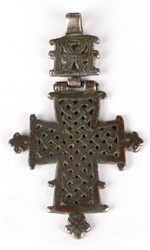 |
|
|
|
Though he had been born into a gypsy family, Tobar considered himself educated and pious, a skilled writer and scribe with an eye for art. As a boy he remembered meeting a Catholic missionary who had taught much to his people, handing out scripture. Though Tobar had been too young to fully understand their meanings, he remembered very well the captivating and powerful symbols and words. It was almost as if he could run his fingers across the pages and absorb an understanding of what was on them. As he grew older, his curiosity for different art forms took him West through Islamic lands until he finally crossed the sea and arrived in the horn of Africa. Along the way he was able to scratch out a living trading in art and religious objects, and occasionally transcribing a text or document for someone.
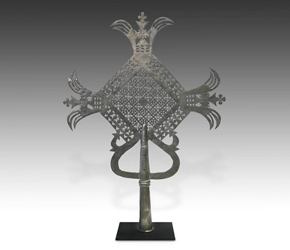 |
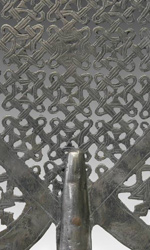 |
|
After leaving the traders, Tobar traveled alone for many days. He used the time for quiet reflection, sometimes looking into his campfire at night and seeing visions. Then, at dusk one evening he met two men resting by a river bend. To his surprise they wore elaborate metal crosses around their necks while carrying intricately designed hand-held crosses. It seemed they could not detach themselves from the symbolism of the crosses. The three men scrambled for a common language and finally settled into Tigrinya, a tongue Tobar had picked up from his time spent in Eritrea. The men revealed they were Orthodox Christian priests on a pilgrimage to the holy sites of Lalibela, where the churches were carved straight from the mountains and chiseled from the roof down. They also revealed that the Church had flourished in Ethiopia and Absynnia for far longer than Tobar imagined. Intrigued, Tobar was invited to join in their pilgrimage. He later wrote in his journals:
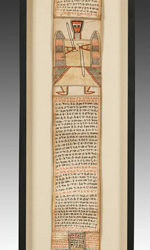 |
|
It is amazing to see Christianity flourish here in Africa. The priest tells me Ethiopia has been a Christian kingdom for over a thousand years, since the 4th century. Lalibela was built in the 12th century. It is truly a magical place. Many have claimed the people of Africa lack faith, but on the contrary, I’ve never seen faith so strong. We spend many hours in theological discussions, and as time moves on I am more and more fascinated with the Ethiopians. They embrace the Orthodox Church, yet there is something distinctly tribal and artistic about their practices and beliefs. It is Christianity laced with local customs and beliefs.
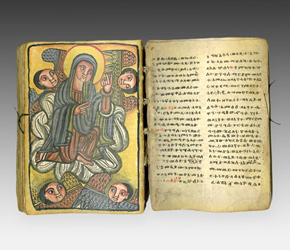 |
|
Today I noticed small scrolls carried by my companions. The scrolls were securely wrapped in leather pouches. I discovered they were talismans believed to contain magic powers. Called ‘healing scrolls,’ it was explained they were used for protection and blessings. Prayers and excerpts from the Gospels were written on thin strips of goat skin in Ge'ez, an ancient language used in liturgical texts and then placed inside the leather. I saw these immediately as works of both art and faith. The tightly rolled scrolls were handwritten in red and black inks made from plant pigments and were accompanied by unique figurative images. The Ethiopian people rely on these scrolls to protect the body and soul. It is a captivating blend of orthodox and local beliefs. I call them “magic scrolls.”
The Bibles my friends carry are so unique they are almost incomparable to the leather bound tomes I once saw as a boy. The covers are made of hand carved wood with fine holes drilled into them to string together the pages. The books are almost the thickness of three fingers, and they are beautifully illustrated. The pages themselves are made of the highest quality vellum, goat skin pounded and stretched until it is super-thin, and the perfect surface for writing. Every stroke of the Ge'ez language and every line of the pictures appear personal and one-of-a-kind. Although my companions agreed to show me their bibles, I could see it was as if I was holding their most prized possessions. I do not know how to explain what I felt when examining their books; except to say I felt a tangible connection to the Bible that I suspect had less to do with content and more to do with artistry. The small imperfections left by the scribe's hand, made the whole a perfection. I was left in awe even though I didn’t understand one word written inside.
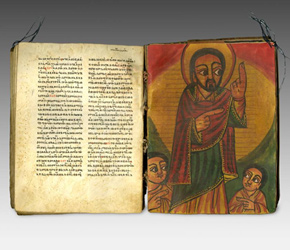 |
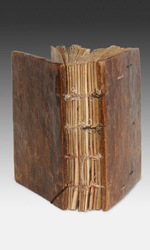 |
|
Although historically, Francisco Alvares is credited as the first missionary to Ethiopia in 1520, it is apparent he never met Tobar. Had the two men crossed paths, Tobar would have explained the futility of converting the Ethiopians to Catholicism. Their faith in the Ethiopian Orthodox Church was as steadfast and unmoving as the churches of Lalibela carved from rocks. Tobar recognized the uniqueness of the Ethiopian faith, especially as it manifest in their art works. He may not have understood the Ge’ez language, but the meaning of what it described was clear. In his last and final journey entry Tobar wrote:
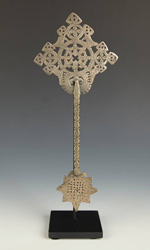 |
|
I find the craftsmanship in the Ethiopian crosses to be the most fascinating of all. I see there are two distinct styles, both crafted in silver. The precious metal gives them obvious intrinsic value; but I see them as valuable works of art. Both types of crosses are made with a technique known as ‘lost wax casting,’ and usually incorporate fine lattice work and geometric patterns in their design. My companions tell me processional crosses are quite significant because of their ritual use. A wooden staff is inserted into the bottom of the cross, which may become highly polished over years of use. These crosses are large and imposing. It is easy to imagine their use in a sacred procession. However, my attention is drawn to hand held crosses. Many of these include a square near the base. I am told the square represents the Ark of the Covenant. What's more, the Ethiopians believe the actual chest containing the stone tablets inscribed with the Ten Commandments resides here in their land! What mystery this place holds! Whether true or not; I shall not forget my journey to this land - for here, there exists an undeniably powerful and beautiful religious language. It is a language imbued forever in the Ethiopian’s art and architecture.
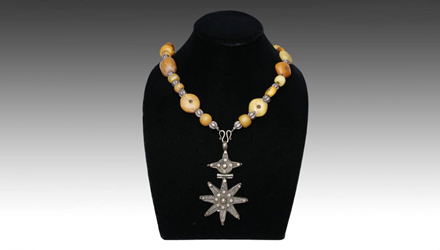 |
Download this Article: An Ancient Language - Christian Art in Ethiopia.pdf